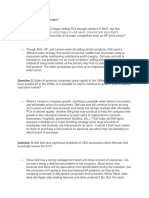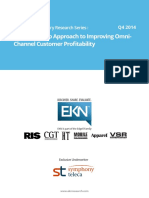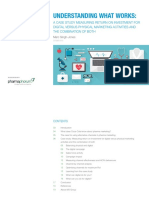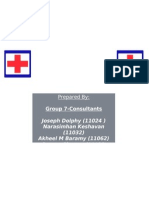0 ratings0% found this document useful (0 votes)
258 viewsAvery Dennison Case Study2
Avery Dennison Case Study2
Uploaded by
bossdzAvery Dennison Corporation achieved business growth through concentration, horizontal integration, and diversification strategies. It concentrated on office products, acquired similar businesses to expand its product portfolio, and diversified into new but related products. Through these strategies, Avery Dennison became a leading manufacturer and supplier of self-adhesive labels, office supplies, and other business and consumer products.
Copyright:
© All Rights Reserved
Available Formats
Download as DOC, PDF, TXT or read online from Scribd
Avery Dennison Case Study2
Avery Dennison Case Study2
Uploaded by
bossdz0 ratings0% found this document useful (0 votes)
258 views6 pagesAvery Dennison Corporation achieved business growth through concentration, horizontal integration, and diversification strategies. It concentrated on office products, acquired similar businesses to expand its product portfolio, and diversified into new but related products. Through these strategies, Avery Dennison became a leading manufacturer and supplier of self-adhesive labels, office supplies, and other business and consumer products.
Original Description:
Avery Dennison Case Study
Copyright
© © All Rights Reserved
Available Formats
DOC, PDF, TXT or read online from Scribd
Share this document
Did you find this document useful?
Is this content inappropriate?
Avery Dennison Corporation achieved business growth through concentration, horizontal integration, and diversification strategies. It concentrated on office products, acquired similar businesses to expand its product portfolio, and diversified into new but related products. Through these strategies, Avery Dennison became a leading manufacturer and supplier of self-adhesive labels, office supplies, and other business and consumer products.
Copyright:
© All Rights Reserved
Available Formats
Download as DOC, PDF, TXT or read online from Scribd
Download as doc, pdf, or txt
0 ratings0% found this document useful (0 votes)
258 views6 pagesAvery Dennison Case Study2
Avery Dennison Case Study2
Uploaded by
bossdzAvery Dennison Corporation achieved business growth through concentration, horizontal integration, and diversification strategies. It concentrated on office products, acquired similar businesses to expand its product portfolio, and diversified into new but related products. Through these strategies, Avery Dennison became a leading manufacturer and supplier of self-adhesive labels, office supplies, and other business and consumer products.
Copyright:
© All Rights Reserved
Available Formats
Download as DOC, PDF, TXT or read online from Scribd
Download as doc, pdf, or txt
You are on page 1of 6
At a glance
Powered by AI
Avery Dennison has achieved growth in business-to-business and consumer markets through focusing on quality products, a wide range of applications, and integrating new technologies. The company uses strategies like acquisitions, alliances, and diversification to improve its ability to meet evolving customer needs.
Avery Dennison has pursued growth through acquiring companies like Myers and Guidex to expand its product portfolio and manufacturing capabilities. It has also formed strategic alliances with software companies to integrate its product templates, broadening its customer reach.
Avery Dennison uses advertising, distribution, customer support, developing customer loyalty programs, trade support, and an active website to raise brand awareness. It also leverages alliances to feature its brand and products within software.
Introduction
A marketplace is divided into consumer markets and organisational markets. In
organisational markets, businesses sell goods or provide services to other business
organisations. Buyers in these markets then use these goods or services to help them
find solutions as they work towards the production or development of other goods or
services to their customers. One organisation that has achieved business growth and
product development in a number of key business to business and consumer markets
in recent years is Avery Dennison Corporation.
ocussing on its subsidiary Avery Dennison Office !roducts "#, this case looks at
how it set about increasing its product portfolio whilst developing a wider range of
new customers. It describes marketing strategies adopted by Avery Dennison and how
it made key decisions that enabled it to create high $uality products at competitive
prices for its business customers and consumers. It also gives an opportunity to
appreciate how a company manages its business growth and brand awareness.
Avery Dennison Corporation is a diversified manufacturing and consumer goods
company whose primary businesses are divided into%
!ressure sensitive adhesives and materials & 'hese range from self&adhesive
papers films and foils for labelling, specialty tapes for medical applications,
high performance graphic films for vehicles and signs to protective coatings.
Consumer and converted products & 'hese include office products, converted
tags and tickets, consumer goods and automotive labelling, peel and stick
postage stamps and battery labels among others.
Avery Dennison (orldwide Office !roducts is the world)s leading manufacturer of
self&adhesive labels for laser and ink*et printers, labelling software, binders, sheet
protectors, inde+ dividers and other, home and school related supplies. orming part
of this Office !roducts Division, Avery Dennison O!"# has a product portfolio sold
under the A,-./ brand which includes%
office labels0
inde+ing and creative printer supplies0
filing and presentation0
office accessories.
'he company)s labelling products have been developed through a variety of alliances
with ma*or software houses such as 1icrosoft, 2otus and Corel. 'hese relationships
and specifically the inclusion of Avery branded product templates within the software,
make it possible to print labels, cards and other creative products from widely
3
available word processing and database packages. 'herefore, the application of new
technology provides Avery Dennison with the very widest range of consumers from
secretarial and administrative users to individual !C users at home and school.
Growth strategies: interpreting the facts
Avery Dennison is the result of the merger in 3445 of two companies% Avery, founded
in America in 3467, and Dennison, a "8 office accessories manufacturer. 'hese two
companies and their ac$uisitions now form Avery Dennison Corporation.
Before the merger Avery had been operating in the "# since 3496, and had
e+perienced significant growth in its own right. It had opened new manufacturing
sites for the industrial division in Cumbernauld :349;<, and office labelling in
1aidenhead :34=7< as well as pursuing an active ac$uisitions policy. In 34>7, for
e+ample, Avery ac$uired 1yers, a manufacturer of plastic and metal desktop
accessories. 1yers had plants in Birmingham and ?ewtown in (ales. 'hree years
later Avery also ac$uired the Birmingham based company @uide+, which was one of
the "#)s market leaders in manila filing products.
'he 3445s were to prove a significant decade in the life of Avery Dennison. In 344A a
decision was taken to streamline manufacturing capability by moving @uide+ from
Birmingham to 1aidenhead, and in this year certain parts of the Avery Dennison
group were combined to form Office !roducts "#. Building on the success of their
growth and integration a new division was added to the group in 344=, in the form of
Avery Dennison Office !roducts -urope.
Growth strategies
Businesses e+pand organically which can be slow, particularly in fast&moving
markets. Others look to e+pand through take&over and ac$uisition.
8ince entering the "# market Avery Dennison has pursued a vigorous growth
strategy involving horiBontal integration, diversification and concentration. 'hese
three concepts provide a basis upon which to build an analysis of Avery Dennison)s
approach to developing its business.
Different approaches to growth
Concentration
'he company had historically focussed on a core group of consumers, individuals in
office based secretarial and administrative roles. 'his can be seen in the way the
company uses its title, Office !roducts, as an umbrella under which to gather
companies closely related by product and market segment. 8imilarly, the various
divisions, which together form Office !roducts "#, concentrate on achieving
e+cellence within a relatively narrow range of products, and so become the brand
name for their specific product sector.
As specialist suppliers, the divisions set about winning a larger share of their current
market, or attempt to e+pand into new ones. ?ot only does Avery Dennison)s
A
concentration strategy help it brand closely associated products, its also strengthens,
in a buyer)s and consumer)s mind, the Avery brand as a ma*or supplier of such
products, which in turn boosts its ability to compete against other companies.
Horizontal integration
Avery Dennison also achieved growth through horiBontal integration by adding
:ac$uiring< businesses that were similar in terms of end consumer and distribution
channels. In pursuing this policy it was able to e+pand its market share of closely
related products. It is possible, therefore, to concentrate manufacture of several
:associated< products from a variety of different factories, some of which have been
ac$uired by horiBontal integration.
Diversification
@rowth strategies through concentration and horiBontal integration are complemented
by diversification% a process which brings about growth through the development of
new products and new sales areas. 'hese new areas may well be related to the
established ones, but they are, nonetheless, distinct from current areas of business.
In addition to diversifying for growth reasons, organisations such as Avery Dennison
often diversify to reduce the risks associated with single product companies. or
e+ample, since its origins as a manufacturer of adhesive labels the Avery Dennison
Corporation has diversified the nature and range of applications of even this one
product. 8imilarly, in the "#, Avery Dennison O!"# has diversified from being
primarily an office label manufacturer to supplying a whole range of office products
and A; creative Cprintable) products such as !hoto&Duality cards, papers, '&shirt
transfers and other novelty items for home and school use. 'he company)s successful
business growth and the establishment of its name as a brand leader illustrate the
strength of its diversification policies. !roduct diversification through horiBontal
integration is clearly evident in the various names of the companies within the Avery
Dennison @roup.
urther evidence of Avery Dennison)s energetic approach to diversification can be
seen in the evolution of one of its primary products% the adhesive label mentioned
above. !atented in 3467 by its inventor . 8tanton Avery, the self&adhesive labelling
process now has many varied and specialty uses. Information technology and software
have added a new range of labelling applications and, in turn, increased the depth of
Avery Dennison)s customer base.
It is worth contrasting Avery Dennison)s concentric diversification with that of
conglomerate diversification. Conglomerate diversification takes place when an
organisation diversifies into areas which are unrelated to its current business.
"nlike Avery Dennison, conglomerates are parent companies which own businesses
that manufacture products that are so different from each other it is difficult for them
to share skills and technologies. (ith the e+ception of finance, it is difficult for
individual companies within a conglomerate to offer each other mutual support.
Avery Dennison)s concentric diversification took place through related products and
6
markets and this contrasts with growth strategies of conglomerates. Avery Dennison
has avoided a strategy which works against concentration and horiBontal integration.
Marketing
1arketing involves understanding customers and meeting their needs. 'his has long
been a ma*or concern of Avery Dennison as the means to achieve business growth.
Indeed, strategies of concentration, horiBontal integration and diversification have all
served to improve Avery Dennison)s capacity to meet customers) needs. An e+ample
is to be found in product diversification which now reaches into retail outlets and
home use with the increasing penetration and use of !Cs. In the wider market&place of
advertising, packaging, design, barcoding and branding, other divisions have satisfied
demanding, technology&led needs in part by creating developmental alliances with
companies in new technology and customers with specific application needs.
'he application of new technologies creates new customer needs. 'he !C revolution
of the late 34>5s in the office, and more recently in the home, led to a demand for
labels that could be printed reliably in personal laser and ink*et printers. 'his
presented a technical problem, given the temperature and the tortuous pathway paper
must take on its way through a laser printer. 'he ability to produce the right kind of
Claser labels) while ensuring that templates were included within the most popular
software, offered Avery Dennison the opportunity for a branded product, capable of
winning the market for laser printing against inferior, non&compatible competition.
Adding value
(hilst branding within the office products market is common, few brands offer real
value as distinct from merely achieving customer awareness. 'he problem for Avery
Dennison, as for any company, is how to add real value to a branded product.
'he value in the case of Avery Dennison)s Claser labels) is to be found in the software
alliances, the $uality of adhesive paper construction and the consumer promise
offered. "ni$ue amongst its competition the CA,-./ laser label) is advertised as
C*am&free) and accompanied by a satisfaction guarantee, while free helplines manned
by dedicated Consumer Centre personnel offer on&going advice and assistance.
Creating customer awareness and loyalty
'he company uses a variety of means to raise customer awareness of the A,-./
brand and its products. 'hese include%
;
Advertising & 8ending messages through the media to inform or influence the
people who receive them.
Distribution & 'he process of making goods available for consumers.
Consumer support&!roviding a range of services before and after sales have
taken place to ensure customers are happy with products they have purchased.
Consumer loyalty& Developing long&term relationship with customers.
'rade support& !roviding help distributors need to enter and develop markets.
An active web site& !roviding information and enablement through free
software downloads.
Another means by which to create brand awareness is through alliances, including
templates within software products. or e+ample, opening 1icrosoft (ord and
looking under tools, envelopes and labels, will reveal the company)s product codes.
'his ensures that the A,-./ brand is brought to the attention of !C users. Alliances
and *oint activities like this have been arranged with other related software producers.
8ince 3447 Avery Dennison has run annual brand awareness campaigns. 'ypical
media for these campaigns have included the following advertising e+ercises%
on tube and escalator panels throughout 2ondon "nderground0
on sides of buses in Birmingham, 1anchester and 2eeds0
in national and regional newspapers0
in the office and secretarial press.
Conclusion
8ince its arrival as a manufacturing force within the "#, Avery Dennison has
e+perienced rapid business growth and market awareness.
Its strategies for growth rely on the $uality of its products and their range of
applications. 'he company has effectively used new technologies and integrated
them with product applications.
7
!"#$I%&#
'( ")plain how strategies of concentration* horizontal integration and
diversification have served to improve Avery Dennison+s capacity to meet
customer needs(
,( Customer loyalty is very important for Avery Dennison( How can the
company maintain loyalty in -oth consumer and organisational markets
in the face of intense competition.
/( "veryone who works for Avery Dennison should have a contri-ution to
make* and inclusivity is very important( Advise on how the company can
implement a good internal marketing system to connect more positively
with its customers(
0( 1hat kind of continuous marketing research programme should the
Avery Group put into place to keep up to date with -usiness trends and
the needs of its customers.
9
You might also like
- Finance - Mentorship With Ultimate Gurus Personal Finance Course by Nikhil KamathDocument13 pagesFinance - Mentorship With Ultimate Gurus Personal Finance Course by Nikhil KamathHarshit Arora0% (1)
- Situational Analysis: 3.1 Detailed Company Analysis (600 Words)Document17 pagesSituational Analysis: 3.1 Detailed Company Analysis (600 Words)IshanShikarkhaneNo ratings yet
- Retail Math Workbook Test W.answersDocument3 pagesRetail Math Workbook Test W.answersc00kiepuss33% (3)
- Netflix Report FinalDocument19 pagesNetflix Report FinalSHALWI PRASADNo ratings yet
- Gap Report - Final EditionDocument105 pagesGap Report - Final Editionapi-222499110No ratings yet
- Question 1: Although Dell Began Selling Pcs Through Retailers in 2007, The FirmDocument2 pagesQuestion 1: Although Dell Began Selling Pcs Through Retailers in 2007, The FirmAlex J. SaoNo ratings yet
- Cadbury Schweppes Capturing Confectionery B: Case SolutionDocument46 pagesCadbury Schweppes Capturing Confectionery B: Case SolutionRadoNo ratings yet
- Summary of Clayton M. Christensen, Jerome H. Grossman & Jason Hwang's The Innovator's PrescriptionFrom EverandSummary of Clayton M. Christensen, Jerome H. Grossman & Jason Hwang's The Innovator's PrescriptionNo ratings yet
- Business Canvas Model: Key Partners: Key Activities: Value Proposition: Customer Relationship: Customer SegmentDocument1 pageBusiness Canvas Model: Key Partners: Key Activities: Value Proposition: Customer Relationship: Customer SegmentSAMSAD BIN ZUBAIR 1712008630No ratings yet
- Group 10: Ajinkya Ambike Prachi Pandey Vandana Wadhwa Shreshtha Shah Vandit Shah Malavika PillaiDocument19 pagesGroup 10: Ajinkya Ambike Prachi Pandey Vandana Wadhwa Shreshtha Shah Vandit Shah Malavika Pillaisujith krishnaNo ratings yet
- Architecture As Brand - Store Design and Brand IdentityDocument8 pagesArchitecture As Brand - Store Design and Brand IdentityYenu EthioNo ratings yet
- Measure, Analyze and Manage: Optimizing Marketing Results With Business AnalyticsDocument12 pagesMeasure, Analyze and Manage: Optimizing Marketing Results With Business AnalyticsorigigiNo ratings yet
- Make Your Organization a Center of Innovation: Tools and Concepts to Solve Problems and Generate IdeasFrom EverandMake Your Organization a Center of Innovation: Tools and Concepts to Solve Problems and Generate IdeasNo ratings yet
- Central Australian College Hobart, Tasmania: BSBSLS501 Develop A Sales PlanDocument32 pagesCentral Australian College Hobart, Tasmania: BSBSLS501 Develop A Sales PlannehaNo ratings yet
- Omnichannel Customer Profitability WebDocument21 pagesOmnichannel Customer Profitability WebAkshitNo ratings yet
- Sales Process Biz PaperDocument6 pagesSales Process Biz PaperDib KerdiehNo ratings yet
- Business Model TamplateDocument2 pagesBusiness Model Tamplateadit_jbNo ratings yet
- Customer Relationship Management in The Pharmaceutical IndustryDocument9 pagesCustomer Relationship Management in The Pharmaceutical IndustryUchenna 'Bonex' OgbonnaNo ratings yet
- DIV2020-Data Intelligence Virtual Conference APAC2020Document7 pagesDIV2020-Data Intelligence Virtual Conference APAC2020Achmad Ardani PrashaNo ratings yet
- Customer Visits Guide RCooper-marketing VisitDocument6 pagesCustomer Visits Guide RCooper-marketing Visitrexy darmawanNo ratings yet
- HP Channel StrategyDocument8 pagesHP Channel StrategyMdFarukHossain0% (1)
- Problem - Solution Fit Template v1Document1 pageProblem - Solution Fit Template v1VINAYAK SIVANo ratings yet
- TBG 2021 Sales Development ReportDocument53 pagesTBG 2021 Sales Development ReportAdriaan StormeNo ratings yet
- Digital SalesforceDocument20 pagesDigital SalesforceKington Jiang100% (1)
- Keywords: 1. Supply Chain ManagementDocument6 pagesKeywords: 1. Supply Chain Managementmushtaque61No ratings yet
- Innovation Model CanvasDocument1 pageInnovation Model Canvasapi-534391196No ratings yet
- (Mcz. Knsy) How COVID 19 Has Pushed Companies Over The Technology Tipping Point FinalDocument9 pages(Mcz. Knsy) How COVID 19 Has Pushed Companies Over The Technology Tipping Point Finalfathir alhakimNo ratings yet
- Case Analysis When New Products and Customer Loyality CollideDocument2 pagesCase Analysis When New Products and Customer Loyality CollideAmir ShameemNo ratings yet
- Ebook Pipeline ManagementDocument17 pagesEbook Pipeline ManagementEhsan UllahNo ratings yet
- Raju OmletDocument2 pagesRaju Omletdeepak vermaNo ratings yet
- Sensory Marketing 1Document6 pagesSensory Marketing 1uddhavkulkarniNo ratings yet
- About The Platform Economy PDFDocument41 pagesAbout The Platform Economy PDFNicholas LoganNo ratings yet
- RT MDocument6 pagesRT MShikhar NigamNo ratings yet
- Submitted byDocument9 pagesSubmitted byABHISHEK SINGH100% (1)
- ConclusionDocument29 pagesConclusionVarunMalhotra100% (1)
- Retail Management ModuleDocument125 pagesRetail Management ModuleJohn Mark Anthony MasNo ratings yet
- Gb510 3666 Supply Chain StrategyDocument4 pagesGb510 3666 Supply Chain StrategyNikhil M PatilNo ratings yet
- Principles For Tapping The BOP MarketDocument3 pagesPrinciples For Tapping The BOP MarketkaihilloverNo ratings yet
- GTM Strategies For Medical DevicesDocument6 pagesGTM Strategies For Medical Devicesbhattacharyasuvodip04No ratings yet
- Business Intelligence: Body of KnowledgeDocument16 pagesBusiness Intelligence: Body of KnowledgeLuciano AraujoNo ratings yet
- Marketing in The Age of AlexaDocument19 pagesMarketing in The Age of AlexaAl Norin AhmadNo ratings yet
- Process Analysis WSDDocument28 pagesProcess Analysis WSDAkhilesh ChaudharyNo ratings yet
- Current Issue and MarketingDocument5 pagesCurrent Issue and Marketingzuraidah hashimNo ratings yet
- Aldi United KingdomDocument435 pagesAldi United KingdomDataGroup Retailer Analysis100% (1)
- field service management software The Ultimate Step-By-Step GuideFrom Everandfield service management software The Ultimate Step-By-Step GuideNo ratings yet
- MT416 - BCommII - Introduction To Business Analytics - MBA - 10039 - 19 - PratyayDasDocument44 pagesMT416 - BCommII - Introduction To Business Analytics - MBA - 10039 - 19 - PratyayDasPratyay DasNo ratings yet
- PESTAL Analysis of Business EnvironmentDocument5 pagesPESTAL Analysis of Business EnvironmentMahabub HaiderNo ratings yet
- IBM Case Study in PharmaDocument16 pagesIBM Case Study in PharmasupriyoNo ratings yet
- Marketing Mix of LLoydsDocument8 pagesMarketing Mix of LLoydsAmit SrivastavaNo ratings yet
- GROUP 3 - Pablo Gil - Case Study 1Document12 pagesGROUP 3 - Pablo Gil - Case Study 1Pablo GilNo ratings yet
- Data Driven Decisions For BusinessDocument8 pagesData Driven Decisions For BusinessFun Toosh345No ratings yet
- Book Presentation of Marketing of High-Tech Products and ServicesDocument23 pagesBook Presentation of Marketing of High-Tech Products and Servicesankushrasam700100% (1)
- Hospital Operations ManagementDocument12 pagesHospital Operations ManagementJay ZatakiaNo ratings yet
- Dark Side of Relationship MarketingDocument5 pagesDark Side of Relationship MarketingAbhishek KhandelwalNo ratings yet
- Crocs Case AnalysisDocument2 pagesCrocs Case AnalysisSofia Spears ElmaNo ratings yet
- Sample of An E-Commerce Start-Up Business Plan byDocument12 pagesSample of An E-Commerce Start-Up Business Plan byHAMID IQBAL MIRNo ratings yet
- Zara Company ReportDocument7 pagesZara Company ReportKimbraPataraNo ratings yet
- Sodastream International LTD.: David Wanetick Managing DirectorDocument56 pagesSodastream International LTD.: David Wanetick Managing Directorkaila80No ratings yet
- Nike Business Model Is Based On Producing and Selling Athletic andDocument5 pagesNike Business Model Is Based On Producing and Selling Athletic andRavish Dabré100% (1)
- Winning at Sales in A Buyer-Empowered WorldDocument5 pagesWinning at Sales in A Buyer-Empowered WorldDeta DetadeNo ratings yet
- 2-30227 EMarketing Plan TheoryDocument48 pages2-30227 EMarketing Plan TheoryJennifer Jones100% (1)
- Mis SiemensDocument9 pagesMis Siemenschanni26No ratings yet
- Summary Diffusion TheoryDocument6 pagesSummary Diffusion TheoryDanielle SmithNo ratings yet
- Castrol Case StudyDocument6 pagesCastrol Case StudybossdzNo ratings yet
- Singapore Airlines Case StudyDocument6 pagesSingapore Airlines Case Studybossdz100% (1)
- Sample AssignmentDocument6 pagesSample AssignmentAteyn Haha100% (1)
- Business PlanDocument15 pagesBusiness PlanRalph Christer Maderazo100% (1)
- Extended AbstractDocument12 pagesExtended Abstractjlancheta19No ratings yet
- Objective Type Questions Mcqs/Fill in The Blanks/True or False (With Answers)Document17 pagesObjective Type Questions Mcqs/Fill in The Blanks/True or False (With Answers)Jenma Maria BinoyNo ratings yet
- Structure of Vacation Destination Choice SetsDocument15 pagesStructure of Vacation Destination Choice SetsLucimari AcostaNo ratings yet
- Taeng MabahoDocument81 pagesTaeng MabahoRyan Jay LegoNo ratings yet
- Shalini Sales CocaDocument77 pagesShalini Sales CocaVivek VermaNo ratings yet
- Hotstar Deck Nov'18Document29 pagesHotstar Deck Nov'18Priyank SarafNo ratings yet
- Integrated Marketing Communication - Project ReportDocument14 pagesIntegrated Marketing Communication - Project ReportKshitij Dhiman100% (1)
- Tarea 4 (5 Pag)Document6 pagesTarea 4 (5 Pag)Ariadne NicolleNo ratings yet
- Price To Scale Practical Pricing For Your High Growth Saas Startup 9798734340721Document221 pagesPrice To Scale Practical Pricing For Your High Growth Saas Startup 9798734340721Ethan John AgbulosNo ratings yet
- Price DiscriminationDocument3 pagesPrice DiscriminationTrisha Gaile R. RañosaNo ratings yet
- Survey Questionnaire Abaca CrochetingDocument5 pagesSurvey Questionnaire Abaca CrochetingCABADONGA, Justin M.No ratings yet
- Market Research BackpackDocument14 pagesMarket Research BackpackJoseph JobyNo ratings yet
- Assignment INB 372 DRAFTDocument6 pagesAssignment INB 372 DRAFTAbdulla Aafnan 1911921630No ratings yet
- Managerial Marketing in The Real WorldDocument88 pagesManagerial Marketing in The Real WorlddigglibertyNo ratings yet
- Driving Digital Strategy - EditedDocument4 pagesDriving Digital Strategy - EditedFOOTBALL IQ100% (1)
- Dina E-Commerce in LebanonDocument24 pagesDina E-Commerce in Lebanonarm masudNo ratings yet
- Ready-To-Eat Main File Mahi JainDocument35 pagesReady-To-Eat Main File Mahi JainRiddhi GoelNo ratings yet
- Product Life Cycle AssigDocument13 pagesProduct Life Cycle AssigBhaskar PalshikarNo ratings yet
- The Role of Trust in Understanding The Impact of Social Media Marketing On Brnad Equity and Brand LoyaltyDocument23 pagesThe Role of Trust in Understanding The Impact of Social Media Marketing On Brnad Equity and Brand LoyaltyAhmedNo ratings yet
- MamtaDocument48 pagesMamtaNirmal BhavsarNo ratings yet
- Properties Identified For Foreclosure: To View Click On A Zip CodeDocument894 pagesProperties Identified For Foreclosure: To View Click On A Zip CodePatricia A Allen- WalkerNo ratings yet
- The Relationship of Utilization of Digital Payment and Customer Satisfaction Among DepEd Employees in Digos CityDocument7 pagesThe Relationship of Utilization of Digital Payment and Customer Satisfaction Among DepEd Employees in Digos CityJournal of Interdisciplinary PerspectivesNo ratings yet
- Business Model Canvas For 'The Vanity Fur' - Pet Care StartupDocument2 pagesBusiness Model Canvas For 'The Vanity Fur' - Pet Care StartupVedant KarnatakNo ratings yet
- Hector BeveragesDocument14 pagesHector BeveragesMohit BhavsarNo ratings yet
- Supply ChainDocument7 pagesSupply ChainLeah BersabalNo ratings yet
- Nakuwa Business PlanDocument49 pagesNakuwa Business Planlamemmalex100% (1)





























































































